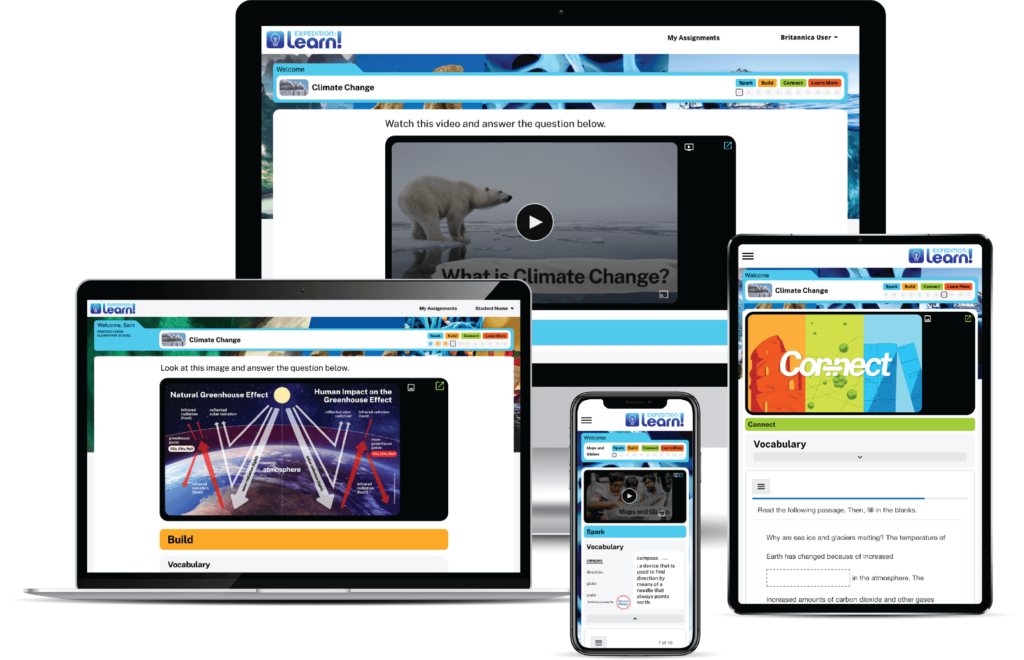Britannica’s Professional Learning programs offer tailored support to elevate educational practices, enhance student outcomes, and create supportive learning environments.

For over 40 years, Britannica has supported teachers in over 100 countries by tailoring programs that cater to their specific needs such as elevating best teaching practices, improving student outcomes, and creating an environment where learners can thrive.
Partner with us to map curriculum, align to standards, and build capacity with targeted programs and initiatives.
Understanding the Science of Reading in the Early Childhood Classroom: A 4-Part Cohort
Course Description: As children discover the world and venture into language development, emerging readers require early learning instruction that prioritizes and emphasizes fundamental skills to foster success in confidence and reading. In this flexible, four-part workshop, we blend the science of reading with the science of effective teaching, emphasizing the importance of adopting an explicit and systematic approach to literacy.
Together, we delve into key reading skills of early learners such as listening and reading comprehension, phonemic awareness, vocabulary acquisition, letter and sound recognition, and phonics and spelling. Participants also uncover ready-to-use instructional materials that complement the core curriculum to provide consistent teaching practices and infuse an element of fun into early childhood classrooms.
Each session focuses on evidence-based strategies that introduce reading pillars and the hierarchical approach to literacy acquisition.
Course Outcomes:
Duration:
12 hours on-site (four 3-hour interactive sessions)* or 8 hours online (four 2-hour sessions)
Format:
In-person (preferred for maximum tactile experiences) and virtual
Flexible:
Sessions can be purchased separately or as a four-part cohort. Course delivery can be customized to fit customer needs.
Audience:
Teachers, administrators, and support staff in early childhood classrooms and schools, early childhood centers, Head Start programs, and additional early childhood environments.
Note:
*Recommended for best results; however, duration and format can be modified as needed.
Understanding the Science of Reading in the K–3 Classroom: A 4-Part Cohort
Course Description: As children progress along their reading journey, they develop the foundational literacy skills they acquired in early childhood. This flexible, interactive, four-part workshop integrates science of reading research findings with evidence-based approaches to reading instruction.
Participants will explore essential skills for developing readers, including alphabetic principles, decoding and encoding, vocabulary acquisition, and language comprehension. Additionally, this workshop delves into ready-to-use instructional materials that align with your core curriculum and promote consistent teaching practices that add enjoyable elements to your classroom.
In each multi-hour, interactive session, we will focus on evidence-based strategies to build essential reading skills.
Course Outcomes:
Duration:
12 hours on-site (four 3-hour interactive sessions)* or 8 hours virtual (four 2-hour sessions)
Format:
In-person (preferred for maximum tactile experiences) and virtual
Flexible:
Sessions can be purchased separately or as a four-part cohort. Course delivery can be customized to fit customer needs.
Audience:
Teachers, administrators, and support staff in K–3 classrooms and schools
Note:
*Recommended for best results; however, duration and format can be modified as needed.
Cultivating Curiosity and Inclusivity Through Play
Course Description: Explore how to pair real-world and imaginative play with rich, nonfiction text to motivate students to build curiosity and develop self-generated questions about topics of greatest interest to them. In this workshop, educators will learn the power of play in developing inclusive and affirming learning environments.
This course incorporates Play Matters content from award-winning educator, author, emotional health consultant, and keynote speaker Hannah Beach.
Course Outcomes:
Duration:
One 3-hour on-site session or one 2-hour virtual session
Format:
In-person and virtual
Audience:
Teachers, administrators, and support staff at early childhood centers, Head Start programs, and after-school programs
Pairings:
This course pairs with Britannica Kids’ Encyclopedia and 5-Minute Really True Stories publications.
Integrating Nonfiction Into Play
Course Description: Unpack the neuroscience behind young children’s developing minds and explore key strategies to engage children in the reading process. In this workshop, educators will learn how to make learning to read a nurturing and confidence-building experience while building the foundations for language, social, emotional, and early literacy development through engaging nonfiction stories.
This course incorporates Play Matters content from award-winning educator, author, emotional health consultant, and keynote speaker Hannah Beach.
Course Outcomes:
Duration:
One 3-hour on-site session or one 2-hour virtual session
Format:
In-person and virtual
Audience:
Teachers, administrators, and support staff at early childhood centers, Head Start programs, and elementary schools
Pairings:
This course pairs with Britannica Kids’ Encyclopedia and 5-Minute Really True Stories publications.
Play-Based Learning in Early Childhood
Course Description: The research is clear: Young children learn best through play. In this workshop, participants unpack the science behind why play is the perfect medium for young children to learn about their world. The session explores how play increases natural curiosity and engagement with learning, helps children develop literacy and communication skills, lowers anxiety and aggression, builds resilience, and fosters social and emotional health.
Our expert trainers provide key strategies to support a nourishing play-based environment along with practical applications and playful activities we can use to support children in deepening and digesting their learning. Discover fluid, nonlinear, and indirect ways to empower young children in the way they learn and grow best—through play! Unpack practical strategies to integrate different kinds of play into early learning to encourage curiosity and support healthy emotional and language development.
Course Outcomes:
Duration:
One 3-hour on-site session or one 2-hour virtual session
Format:
In-person and virtual
Audience:
Early childhood educators, including childcare staff, Head Start programs, Pre-K teachers, and teachers aides
Pairings:
This course pairs with Britannica School (Early Elementary) and ImageQuest Jr.
Early Learning and the Science of Reading
Course Description: As children develop language and discover the world around them, they begin to establish letter and sound recognition and build vocabulary. This is when book and print awareness begins. Decades of evidence-based research and brain science show that children learn best through explicit and systematic literacy instruction.
This comprehensive workshop explores approaches to skills such as listening comprehension, phonemic awareness, vocabulary acquisition, letter and sound recognition, phonics, spelling, reading comprehension, and text fluency. In this interactive session, participants will examine brain development, the hierarchy of literacy acquisition, and the five key pillars of the Science of Reading.
Course Outcomes:
Duration:
One 3-hour on-site session or one 2-hour virtual session
Format:
In-person and virtual
Audience:
Early childhood educators, including childcare staff, Head Start programs, Pre-K teachers, and teachers aides
Pairings:
This course pairs with Britannica School (Early Elementary and Elementary), ImageQuest, and ImageQuest Jr.
Supporting English Learners Through Rich Text and Media
Course Description: Participants will explore how to successfully support English-language learners by integrating rich resources and strategies into their curriculum. The session will provide participants with an opportunity to engage in meaningful, collaborative discussions while navigating diverse multimedia resources to demonstrate rich and authentic teaching and learning experiences for educators and students.
Course Outcomes:
Duration:
One 3-hour on-site session or one 2-hour virtual session
Format:
In-person and virtual
Audience:
Instructional staff, including teachers, librarians, and administrators
Pairings:
This course pairs with Britannica School and Expedition: Learn!
Defining 3 Types of Language Learners: Sequential-Simultaneous-Spontaneous
Course Description: Establish a critical foundation for assisting educators as they work with emergent bilingual or multilingual students to achieve academic success. Participants will investigate and understand how language acquisition happens for language learners through a methodology and analysis of the typical student population in the 21st-century classroom. Participants will be provided with opportunities to engage in meaningful, collaborative discussions while exploring theories and research regarding the different experiences of multilingual learners. Examples of real-world scenarios will demonstrate the scaffolded alignment to Britannica Education products.
Course Outcomes:
Duration:
One 90-minute on-site or virtual session
Format:
In-person and virtual
Audience:
Instructional staff, including teachers, librarians, and administrators
Pairings:
This course pairs with Hello Britannica, Britannica School, or Britannica Escolar or can be a standalone.
Effective Instruction for Bilingual and Multilingual Learners: Applying Critical Research-Based Practices
Course Description: This course covers key components that support accessing and internalizing content area objectives for two types of language learning goals.
Goal 1: Participants will review L1 and L2 teaching and learning methods for emergent bilinguals in elementary classrooms.
Goal 2: Participants will acquire new knowledge that builds an understanding of the different academic experiences of K–12 multilingual learners.
An analysis of the typical student population in the 21st-century classroom will allow attendees to investigate and understand how language proficiency evolves during the acquisition process. Through the examination of critical research-based practices, participants will engage in meaningful, collaborative discussions while investigating proven strategies and instructional practices that enhance the academic experiences in both bilingual and multilingual classroom settings. The examples offered demonstrate connections and scaffolds that integrate with Britannica Education products.
Course Outcomes:
Duration:
One 3-hour on-site session or one 2-hour virtual session
Format:
In-person and virtual
Audience:
Instructional staff, including teachers, librarians, and administrators
Pairings:
This course pairs with all Britannica Education products.
Planning the Implementation of Successful Multilingual Programs: Guidelines, Goals, and Growth Measures that Result in Academic Achievement for Language Learners
Course Description: In planning the implementation of successful multilingual programs, guidelines, goals, and growth measures result in academic achievement for language learners. This course covers the three stages of program design that support effective outcomes when working with diverse learners.
This course encompasses the process of designing and conceptualizing each phase of implementation. The focus is on the effective predictors of optimal outcomes: academic achievement of language learners, targeted bilingual instruction, varied stimulating activities, and multiple types of assessments when working with diverse learners. The implementation paths proposed in this course will demonstrate how to integrate Britannica Education resources best to achieve optimal results.
Course Outcomes:
Duration:
One 3-hour on-site session or one 2-hour virtual session
Format:
In-person and virtual
Audience:
Instructional staff, including teachers, librarians, and administrators
Pairings:
This course pairs with all Britannica Education products.
The Reflective Leader: Shaping the School Environment
Course Description: This session centers around building a positive, culturally responsive school culture and is designed as a concise course exclusively for institutional leadership. Leaders identify effective, research-based practices that strengthen relationships among teachers, students, and staff through engaging, collaborative activities. In addition, educators are equipped with the appropriate tools and strategies that promote effective practices within classrooms, across entire schools, and throughout local communities, creating a positive and empowering school environment.
Course Outcomes:
Duration:
3 hours on-site* or 2.5 hours online
Format:
In-person* and virtual
Audience:
School and district leaders
Note:
*Recommended for best results; however, duration and format can be modified as needed.
Teaching for Success: Reaching The Early Learner
Course Description: Educators examine research-based strategies that support early childhood development. Participants uncover the elements of play through varied perspectives while incorporating personal learning habits and selecting books and resources that support a range of viewpoints and experiences. This session also dives into the competencies needed to begin building a responsive learning framework that integrates elements such as literacy, rituals, and routines as well as methods to apply these practices to teaching and learning.
Course Outcomes:
Duration:
12 hours (four 3-hour sessions tailored to educator/institution needs)*
Format:
In-person* and virtual
Audience:
Educators and administrators
Note:
*Recommended for best results; however, duration and format can be modified as needed.
Teaching for Success: Reaching Every K-12 Learner
Course Description: This four-part session focuses on building a positive and supportive school climate that responds to the unique needs of learners. Participants identify effective, research-based practices that strengthen relationships among teachers, students, and staff through engaging, collaborative activities. In addition, educators are equipped with the appropriate tools and strategies that promote effective practices within classrooms, across entire schools, and throughout local communities, creating a positive and empowering school environment.
Course Outcomes:
Duration:
12 hours (four 3-hour sessions tailored to educator/institution needs)*
Format:
In-person* and virtual
Audience:
School staff and administrators
Note:
*Recommended for best results; however, duration and format can be modified as needed.
Developing a Mindful and Responsive School Climate
Course Description: These professional-learning sessions focus on building a positive and supportive school climate and an overall space where learners engage. This course builds upon the Reaching Every K-12 Learner course and extends to include support staff, classroom aides and assistants, as well as community members. Participants identify effective, research-based practices that strengthen relationships among teachers, students, staff, and the broader community through engaging and collaborative activities. In addition, educators are equipped with the appropriate tools and strategies that promote effective practices within classrooms, across entire schools, and throughout local communities, creating a positive and empowering school environment.
Course Outcomes:
Duration:
12 hours (four 3-hour sessions tailored to educator/institution needs)*
Format:
In-person* and virtual
Audience:
School staff and administrators, teacher assistants, coordinators, community members
Note:
*Recommended for best results; however, duration and format can be modified as needed.
Perspectives in Practice: How Experiences Shape Our Thinking
Course Description: Through personal reflection and open discussion, this workshop explores how personal experiences and individual perspectives shape interactions and decision-making. Participants are encouraged to increase their own self-awareness and consider how their experiences and perspectives may show up in their relationships with others. The workshop explores the skills and strategies that support safe, respectful, and effective learning environments.
Course Outcomes:
Duration:
One 3-hour on-site session or one 2-hour virtual session
Format:
In-person and virtual
Audience:
Classroom educators, teacher aides, paraprofessionals, leadership, and coaches
Pairings:
This course pairs with all Britannica products as we explore the world around us and search curated and factual content.
Amplifying the Unheard Voices of American History
Course Description: This session provides a tiered perspective on American history by highlighting marginalized groups to better understand the complexities of modern American society. Participants will engage in small and large group discussions and reflection throughout the session while navigating United States cultural history, from personal and local perspectives to broader, global viewpoints. Attendees will discuss how they can encourage students to ask questions, conduct research, and broaden their horizons through multimodal instruction.
Course Outcomes:
Duration:
One 3-hour on-site session + one 2-hour online session
Format:
In-person and virtual
Audience:
Instructional staff, including teachers, librarians, and administrators
Pairings:
This course pairs with Britannica School, Britannica Escolar, Britannica Library, Britannica Academic, and Britannica Expedition: Learn!
Project-Based Learning
Course Description: This four-part cohort immerses educators in Project-Based Learning (PBL) foundational principles and best practices taught by PBL-certified educators at Britannica Education. Participants will engage in a hands-on, collaborative learning experience that will span critical aspects of PBL, from understanding the principles and how it enhances student learning to project design and assessment. Come away equipped with the tools and knowledge to reimagine and transform classrooms into dynamic, student-centered learning environments.
Course Outcomes:
Duration:
12 hours on-site (four 3-hour interactive sessions)*
Format:
In-person* and virtual
Audience:
K–12 teachers, teacher leaders, and instructional leadership team members
Note:
*Recommended for best results; however, duration and format can be modified as needed.
Course Description: Specially designed for educators who teach intermediate and secondary courses, this interactive session helps teachers build targeted learning tasks to support unique student literacy needs without sacrificing curricular needs. Learn how high-quality digital content, including Britannica’s trusted, content-rich digital solutions, can be used to reach all learners and build supportive literacy skills in intermediate and secondary science. This session also emphasizes comprehension strategies and cross-curricular vocabulary skills.
One 3-hour on-site session or one 2-hour virtual session
In-person* and virtual
Instructional staff, including teachers, librarians, and administrators
This course pairs with Britannica School, Britannica Escolar, and Britannica Expedition: Learn!
Note:
*Recommended for best results; however, duration and format can be modified as needed.
Course Description: Explore the skill sets necessary for students to understand information needs and develop information literacy. In this workshop, participants will discover targeted learning tasks that empower students to determine how to locate, evaluate, and use information. Educators will receive a five-step guide that seamlessly teaches vital skills students will apply to research, both in their current school settings and in their future college and career journeys.
One 3-hour on-site session or one 2-hour virtual session
In-person and virtual
Instructional staff, including teachers, librarians, and administrators
This course pairs with Britannica School (Early Elementary and Elementary) and ImageQuest Jr.
Course Description: Students today are faced with unprecedented challenges in determining fact from fake, as they are bombarded with misinformation and disinformation through conventional and social media. As artificial intelligence becomes more advanced and prevalent, these challenges grow more difficult and complex. In this session, educators will explore trusted, content-rich resources, including Britannica School’s curated resource packs and lesson plans, that support student research, media literacy fundamentals, misinformation and disinformation concepts, and action plans to determine fact from fake.
One 3-hour on-site session or one 2-hour virtual session
In-person and virtual
Instructional staff, including teachers, librarians, and administrators
This course pairs with Britannica School and Britannica Expedition: Learn!
Teaching for Tomorrow: Media Literacy Made Easy
Course Description: Media literacy is an essential skill in today’s fast-paced digital world, empowering students to critically evaluate information, recognize bias, and engage responsibly with the digital content they encounter. This course offers educators a comprehensive introduction to media literacy, providing clear definitions, practical strategies, and actionable tools for classroom integration.
Through real-world examples and approachable techniques, educators will explore how digital media, often influenced by artificial intelligence, shapes information consumption and behavior—and discover ways to guide students in navigating these complexities. From guiding students to independently evaluate and question media to cultivating a future-focused teaching mindset, this course helps teachers adapt instructional practices to ensure students keep pace with the future of education.
Course Outcomes:
Duration:
One 3-hour on-site session or one 2-hour virtual session
Format:
In-person and virtual
Audience:
Instructional staff, including teachers, librarians, and administrators
Pairings:
This course pairs with Britannica School, ImageQuest, LaunchPacks, and Expedition: Learn!
Teaching for Tomorrow: Getting Started with AI in the Classroom
Course Description: Artificial intelligence (AI) is transforming how we live, work, and learn, making it a vital topic in education. From lesson planning to student engagement, AI is unlocking opportunities for personalized learning and collaboration. This course provides a comprehensive introduction to AI in educational settings, explaining its key concepts and its role in shaping the classrooms of tomorrow.
Through real-world examples and practical strategies, this course examines how AI can enhance teaching practices—whether by streamlining classroom tasks or fostering critical thinking and creativity in students. It also explores how educators can harness the potential of AI to innovate and empower students for the future, while delving into media literacy to help critically evaluate AI tools, understand their impact, and guide students in using them responsibly.
Course Outcomes:
Duration:
One 3-hour on-site session or one 2-hour virtual session
Format:
In-person and virtual
Audience:
Instructional staff, including teachers, librarians, and administrators
Pairings:
This course pairs with Britannica School, ImageQuest, ImageQuest Jr., LaunchPacks, and Expedition: Learn!
Teaching for Tomorrow: When Media Literacy Becomes Critical
Course Description: This course explores the point where media literacy shifts from a helpful skill to an essential one, focusing on the critical need to understand how systems, ideologies, and power dynamics shape the media we consume and create. It goes beyond foundational media literacy to examine how representations in media influence culture, reinforce societal structures, and reflect power relationships.
Participants will delve into activities and case studies that challenge them to think critically about media, create informed content, and interrogate the intersections of power and knowledge. By the end of the course, educators will have the tools to equip students with the skills to thoughtfully navigate the digital world and critically assess the forces shaping their media environment.
Course Outcomes:
Duration:
One 3-hour on-site session or one 2-hour virtual session
Format:
In-person and virtual
Audience:
Instructional staff, including teachers, librarians, and administrators
Pairings:
This course pairs with Britannica School, ImageQuest, ImageQuest Jr., LaunchPacks, and Expedition: Learn!
• Educator access
• Product design basic features
• Student access
• Hands-on and interactive
• First session within 30-60 days
• Second session mid-year
• Designated Q&A time for specific product needs
• Educator access
• Product design basic features
• Student access
• Hands-on and interactive
• Educator access
• Product design basic features
• Student access
• Hands-on and interactive
• Educator access
• Product design basic features
• Student access
• Hands-on and interactive
• First session within 30-60 days
• Second session mid-year
• Designated Q&A time for specific product needs
• Educator access
• Product design basic features
• Student access
• Hands-on and interactive
• Educator access
• Product design basic features
• Student access
• Hands-on and interactive
Help your students and teachers get started with self-guided training modules.










At Britannica Education, our purpose is to empower educators to create engaging and meaningful learning experiences that ignite curiosity. We believe every student has the ability to learn and grow. We are committed to supporting educators in their efforts to help learners reach their full potential. Read more ▸
View the available lessons for elementary and middle school science and social studies
Choose between 4 reading levels to meet the needs of every learner
Each Expedition: Learn! Lesson begins with a video to spark students’ interest in the topic

Ignite the spark of curiosity and accelerate learning

For Elementary or High School reading levels, please contact us.